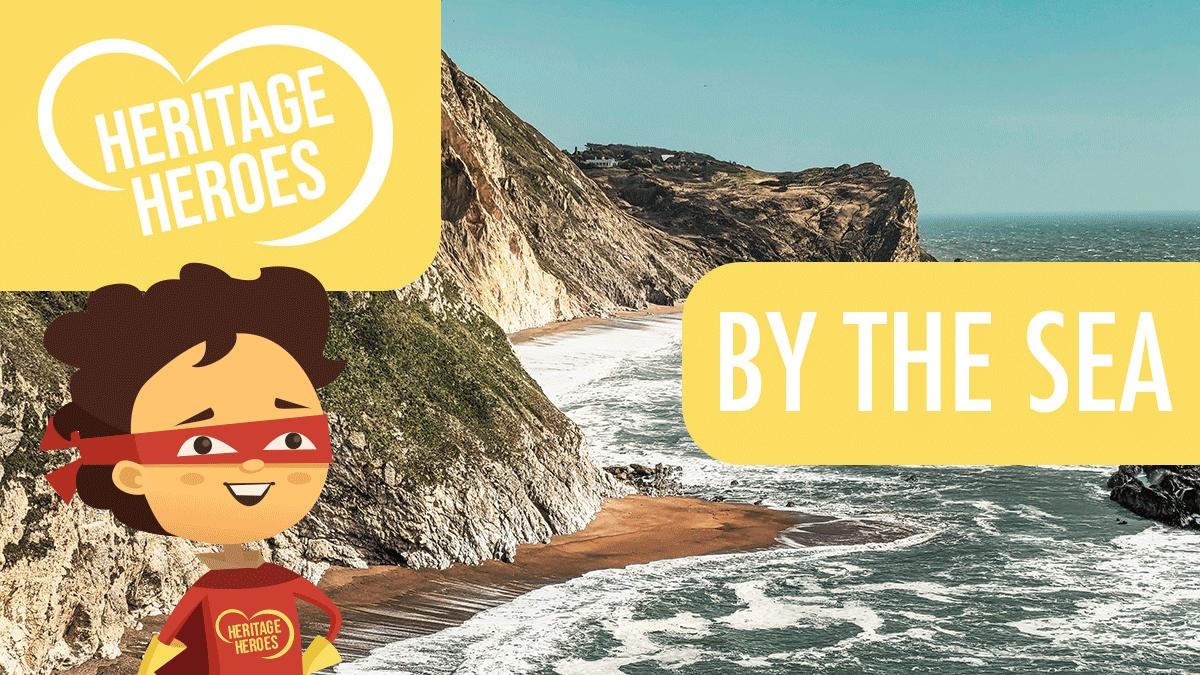Wherever you live, there’s treasure to be discovered!
Not just gold and gems, but stories of buildings, locations and people.
Our heritage is a great wealth… and it’s all around us. Sometimes standing proud in the open air – sometimes hidden behind some bushes.
And to help find it, we’re looking for Heritage Heroes – could you be one?
You can find clues in all sorts of places to find out what happened in your street, neighbourhood and further afield, from famous visitors to historic events.
Here are three tips to help you become a Heritage Hero…

HERITAGE HEROES. AN INSPIRING AUDIO PRODUCTION FOR FUN KIDS. MADE POSSIBLE WITH THE NATIONAL LOTTERY HERITAGE FUND, WITH THANKS TO NATIONAL LOTTERY PLAYERS.
Fishing
Coastal towns, whether holiday destinations, fishing harbours, ports or naval bases, have changed dramatically over the years, and by looking for evidence of these changes, you can learn more about their – and our heritage.
For many centuries, the only people who lived by the sea were people who worked at sea. Either in the navy or as fishermen and merchants carrying goods.
They would also work with their families and others who supported them – from rope and netmakers to shipwrights – people who built the boats.
One of the very oldest sea trades is that of the fisherman.
If you’re by the sea, look for clues to the old fishing industry. This could be the names of buildings or shop signs, boat yards and jetties.
And see how many fish symbols you can see!
To find out about the people who were part of the area’s history, look online or in local museums for old photographs and artifacts.
See if you can read personal memories or documented interviews – or listen to an old sea shanty – it’ll give you an insight into local life.
Learn more about Sea Shanties
It was a tough existence, sailing into waters whatever the weather – with a high chance of being drowned or facing injury.
Some other heritage to look out for are things that would assist them – lighthouses that would show sailors a safe passage and lifeboats that would have rescued them if they were in trouble.
Why not see if you can make a poster about your local seaside town?
Which town will you pick?
What facts are important to include?
Seaside Resorts
Over time, fishing became concentrated in larger ports, and during the 18th century, more and more people began to see the seaside as a healthy place to relax and recuperate.
An early resort was Scarborough where people would drink the water, bathe and enjoy horse races on the beach – although initially it was mainly only the rich who came!
As railway lines sprung up, quite a few were built to serve seaside resorts – from the Cornish Riviera and the South Coast, to North Wales and the Northern coastlines.
Coastal towns grew into bustling holiday destinations catering for thousands of visitors, with fish and chip shops, ice cream sellers, donkey rides and penny arcades!
Piers are a link between the old fishing industries and new seaside resorts – they’ve always been used to moor boats but became more ornate places to take a stroll and look at the sea view!
Sea Defences
As an island, the UK has always been prone to attack from the sea.
As well as having a navy to defend our shores, there are many buildings and structure that were built for defence.
As well as castles on top of the cliffs, forts in the sea were great ways to spot invaders and defend the coastline.
Forts were built in the Solent in response to the threat of a French invasion under Napoleon, with Maunsell Forts built in the Thames and Mersey estuaries during the Second World War.
On land, concrete pillboxes helped protect beaches and other strategic positions – of 28,000 built in 1940, around 6,500 still survive.
Now it’s over to you! Here’s a reminder of things to look for to help you find out about the place where you live.
1 – If you’re in a seaside resort, take a stroll along a promenade and check out the piers and amusement arcades. See if you can tell their age from their design.
2 – And look out for sea defences – from castles and forts to pillboxes. There might also be an old naval dockyard to visit.
3 – And if you were wondering about the heritage of fish and chips, it’s believed that the first fish and chip shops opened in 1860… in London’s East End!
Here are some helpful links that will help you become a Heritage Hero!
Sea Defences: http://www.pillbox-study-group.org.uk/uk-defence-locations/
Learn more about Merchants: www.nationalarchives.gov.uk/help-with-your-research/research-guides/merchant-trade-records-port-books-1565-1799








